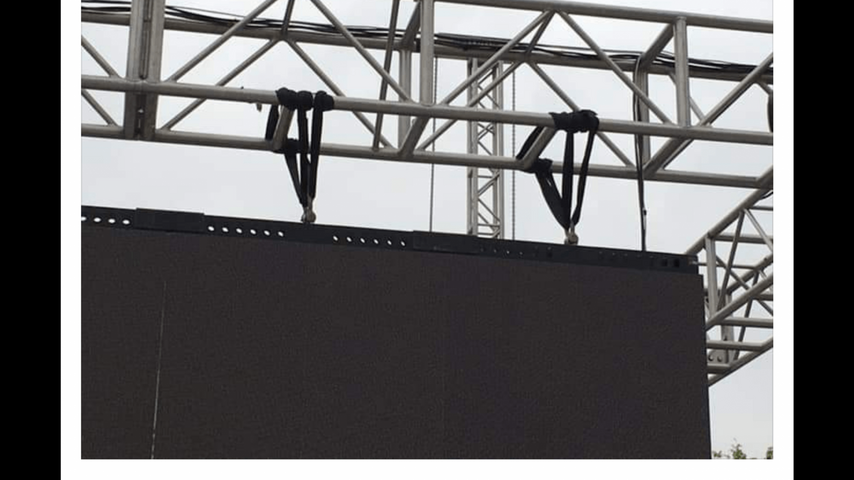You are using an out of date browser. It may not display this or other websites correctly.
You should upgrade or use an alternative browser.
You should upgrade or use an alternative browser.
Issues with this rig
- Thread starterDagger
- Start date
Possibly... I just don't see it.Saw this . . Potential failure?
BillConnerFASTC
Well-Known Member
Sorry guys. I cannot upload the file.
Website issue?
How big is the file?
BillConnerFASTC
Well-Known Member
Is this the file or link to it on Photobucket or some service? Download the file and then copy here. That's what I have to do with Goggle photos at least.
RonaldBeal
Well-Known Member
definite failure
BillConnerFASTC
Well-Known Member
What a capital idea!
Ted jones
Well-Known Member
Finally able to upload the image.
Potential failure? Sure, everything is. Whether or not this depends on multiple things but the first issue I have is that it violates one of the Primary Directives of Rigging - compression, not tension. The video wall should be rigged from the top truss chords, near a node point. More ideal would be a choke around the bottom chord, a wrap around the top chord, and then back through the middle of the truss to attach to the video wall bumper. From the number of wraps on the downstage chord it appears that the slings are of different lengths.
The other is that attachments should be metal to metal whenever possible. If these are "gak flex" (internal wire rope instead of polyester fibre), the slings meet that requirement.
Finally it appears that the video wall is attached directly to the roof structure, meaning the load is being raised with the roof. This is a serious violation of temporary demountable entertainment structure protocol.
The video wall supplier should supply appropriate chain hoists and rigging for their gear. This is a "fail" even if it was successfully lifted and didn't fall from the sky.
Potential failure? Sure, everything is. Whether or not this depends on multiple things but the first issue I have is that it violates one of the Primary Directives of Rigging - compression, not tension. The video wall should be rigged from the top truss chords, near a node point. More ideal would be a choke around the bottom chord, a wrap around the top chord, and then back through the middle of the truss to attach to the video wall bumper. From the number of wraps on the downstage chord it appears that the slings are of different lengths.
The other is that attachments should be metal to metal whenever possible. If these are "gak flex" (internal wire rope instead of polyester fibre), the slings meet that requirement.
Finally it appears that the video wall is attached directly to the roof structure, meaning the load is being raised with the roof. This is a serious violation of temporary demountable entertainment structure protocol.
The video wall supplier should supply appropriate chain hoists and rigging for their gear. This is a "fail" even if it was successfully lifted and didn't fall from the sky.
Am i getting this right, compression is better than tension?
Am i getting this right, compression is better than tension?
Yes, as a general rule and when using conventional box-type truss. At least 1 exception has been noted and that's why it's important to understand that the *concept* is universal but some truss products don't implement in the same way as other truss products. Post #8 from Ethan in this thread: https://www.controlbooth.com/threads/choking-spanset-on-top-chord-instead-of-bottom.45636/
If you suspend conventional box truss from the top chords and the video wall from the bottom chords, in essence you are exerting forces that attempt to pull the truss apart. The diagonal braces ("lacing") spread and attempt to distribute the load and you'll note that on the opposite side of the truss the lacing is "upside down". Placing the top and bottom chords in tension does nothing to spread the load and indeed, at that point the only thing holding the truss together is the lacing. If you can't picture this in your mind and immediately understand why this is a Very Bad Thing, it's time to let someone else do whatever it is you're doing. I'm serious as a Mandalay Bay video wall rigging collapse... edit addition: Some manufacturers say it's okay to put their truss in tension, and if they say so in writing, fine. I'd want to see an engineering report before applying any significant loading...
You can't learn the craft of rigging from a book but you can learn the physics of rigging and the materials and methods used. I highly recommend Harry Donovan's "Entertainment Rigging". It's been previously released as "Arena Rigging". Also on my list is "Uncle" Bill Sapsis's "Entertainment Rigging for the 21st Century".
Last edited:
Similar threads
Control/Dimming
Trouble with Non Responsive Lighting Control
- Replies
- 2
- Views
- 1K
- Replies
- 13
- Views
- 812
Users who are viewing this thread
Total: 1 (members: 0, guests: 1)



